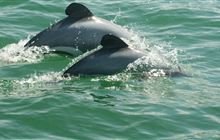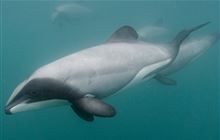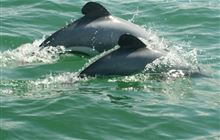Hector's and Māui dolphin incident database
Introduction
We maintain a database of incidents based on reported events. Incidents include dead or stranded Hector’s and Māui dolphins and those caught by fishers as accidental bycatch.Reports may be of dolphins:
- alive stranded on the beach
- injured but alive at sea
- washed up dead on beach
- found floating dead at sea or
- caught during commercial or recreational fishing (bycatch), may be dead or released alive.
In this section
Incident updates and necropsy results
Data on Hector's and Māui dolphin incidents are available in two formats:
- On our website as annual summary tables
- These tables contain the basic details of each incident.
- Copies of any necropsy reports are included here.
- These are updated regularly as incidents occur - with a delay of up to 4 weeks to allow for verification of details of the incident.
- As a downloadable spreadsheet
- The spreadsheet contains all non-sensitive information known about an incident, as it appears in our database.
- Sensitive information may be removed due to personal privacy or commercial sensitivity.
- Date and location details of fisheries bycatch incidents may also be obscured for commercial sensitivity purposes.
- The spreadsheet is updated quarterly in Feb, May, Aug, and Nov.
Bycatch data
DOC works closely with Fisheries New Zealand on publishing information about Hector’s and Māui dolphin bycatch. To maintain transparency, DOC publishes regular updates of these events, alongside publication of non-fisheries related incidents.
You can download a complete dataset of non-fish and protected species accidental bycatch on the Ministry for Primary Industries website.
Annual summaries
The links below contain annual tables with details about Hector’s and Māui dolphin incidents. We update these tables regularly.
- 1 August 2024 - 31 July 2025
- 1 August 2023 - 31 July 2024
- 1 August 2022 - 31 July 2023
- 1 August 2021 - 31 July 2022
- 1 August 2020 - 31 July 2021
- 1 August 2019 - 31 July 2020
- 1 August 2018 - 31 July 2019
- 1 August 2017- 31 July 2018
- 1 August 2016 - 31 July 2017
- 1 August 2015 - 31 July 2016
- 1 August 2014 - 31 July 2015
- 1 August 2013 - 31 July 2014
- 1 August 2012- 31 July 2013
- 1 August 2011 - 31 July 2012
- 1 August 2010 - 31 July 2011
- 1 August 2009 - 31 July 2010
- 1 August 2008 - 31 July 2009
- 1921 - 2008
Download the data
Download a complete copy of DOC’s national database for Hector’s and Māui dolphin incidents.
Spreadsheet of Hector's and Māui dolphin incidents: 1921 to 31 October 2024 (XLS, 314K)
Some incidents may involve multiple animals, so the data is provided in two tabs: one for the event information, and one for the individual information.
With the 'individuals' tab, data is displayed as one row per individual. Use the 'MarMam observation ID num' to identify individuals involved in the same event. Event information will be the same for each individual in that event.
For more information about the data, see the user information guide (PDF, 472K).
Where reports come from
Our work to learn more about the threats to these dolphins relies on prompt reporting of dead dolphins by members of the public. The database tends to have more reports from areas that have higher visitor numbers.
We also rely on reports from fishing vessels that have caught dolphins – this is a legal requirement.
Currently, investigation of all Māui and Hector’s dolphin mortality includes:
-
photographing the dolphin as it was found
-
taking a genetic sample and measurements
-
post mortem (necropsy).
Necropsy programme
Learning about why dolphins die can help us manage the threats to them. This requires a post-mortem examination (necropsy). The aim of the post-mortem is to try to determine the cause of death.
The post-mortem involves a physical (gross) and microscopic (histological) examination. A report is submitted for each examined dolphin with the results of the post-mortem (pathology report). These reports are made available in the annual tables above. The examiner classifies the post-mortem results as one of the following options:
-
Entanglement (Known, Probable, or Possible)
-
Other human induced (Known, Probably, or Possible)
-
Vessel strike
-
Natural causes (General, Maternal Separation, or Disease)
-
Unknown trauma
-
Euthanasia
-
Indeterminable (unable to be determined)
-
Other
The cause of death may be from a combination of several factors.
It is not always possible to determine the cause of death, and factors such as decomposition, and freezing can contribute to this.
Dead dolphins won't always be sent for necropsy due to decomposition levels, or if the body is lost to the tide before it can be collected.
What the database contains
The database contains a variety of information about each dolphin, such as:
-
type of incident
-
sex
-
length
-
where it was found
-
any background information about the incident
-
necropsy results or suspected cause of death.
The database also contains results from any DNA analysis done. This analysis can provide genetic sex and population information (haplotype). A DNA sample is required to determine between the Hector's and Māui dolphin subspecies.
Haplotypes are portions of DNA that are only passed on by females, so each dolphin has the same haplotype as its mother. Haplotypes are assigned letters of the alphabet. There are 20 haplotypes in Hector's dolphins, and one that is unique to Māui dolphins (G).



